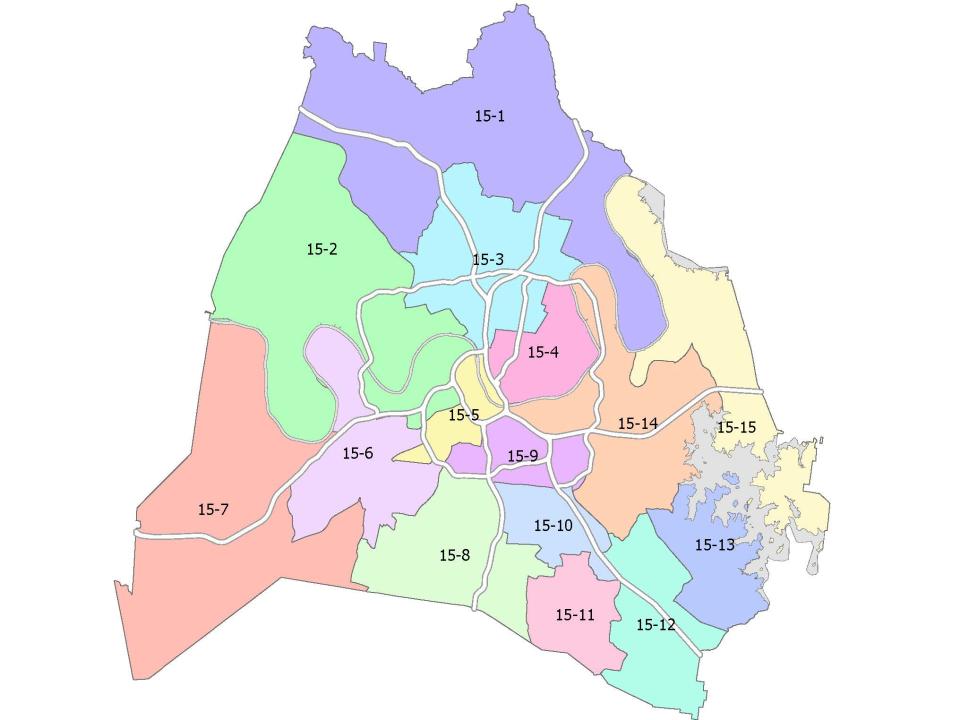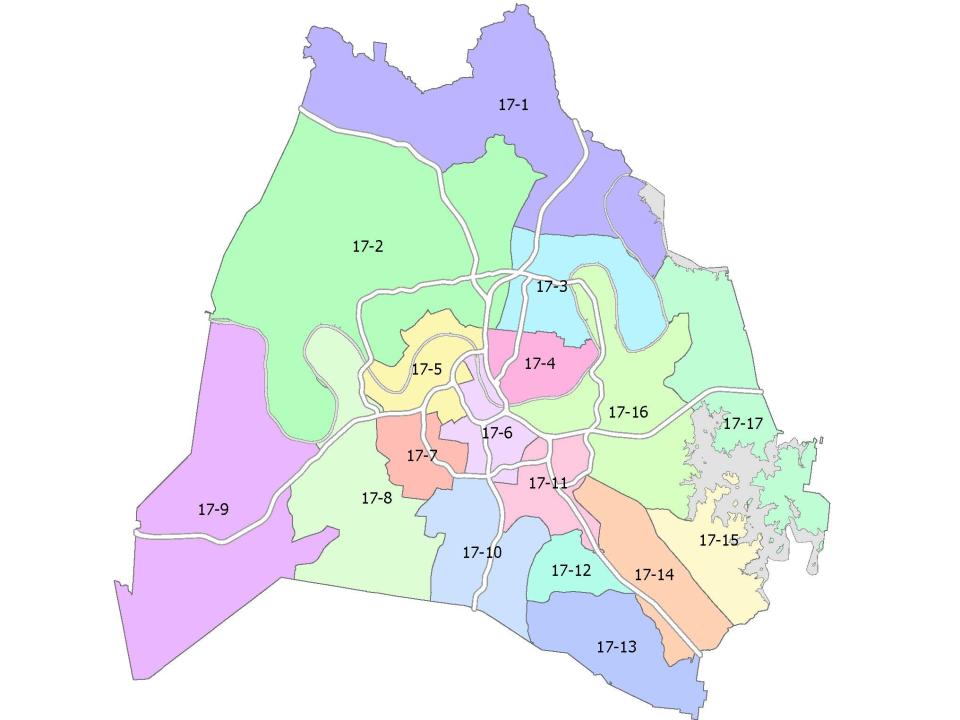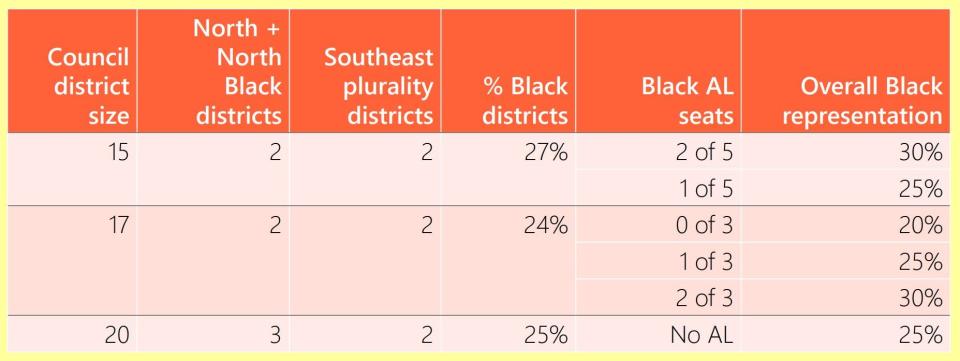How many districts will Nashville have? New maps offer two scenarios
Nashville planners released two draft maps Friday for a smaller Metro Council — options produced on a constricted timeline to comply with a new state law limiting city and metropolitan councils to 20 members or fewer.
Nashville's current Metro Council has 35 district council members and five at-large members who represent county residents as a whole.
The maps present proposed district lines for two scenarios:
15 council districts with five at-large members
17 council districts with three at-large members
These scenarios aren't exhaustive — the public can suggest other configurations of district and at-large seats and suggest changes to these initial draft maps.
Interactive versions of the maps are available at redistrict.nashville.gov, where members of the public can identify which district would include their home. The public can also submit comments, view others' comments and indicate whether they agree or disagree with posted suggestions.
The Metro Planning Department will also hold in-person engagement hours at four locations throughout the county from March 27 through 30.
State law requires the planning department to present a map to Metro Council by April 10, though the council can choose to accept or reject it.
"I have great confidence in the skills that our team brings around data and demographic analysis, as well as their on-the-ground experience within the community due to the last redistricting effort (in 2021)," Metro Planning Department Executive Director Lucy Kempf said Friday. "That said, we anticipate a tough week ahead, as we are talking about cutting council roughly in half, and that will have a variety of implications for our city and individually, council members."
The department is releasing its first draft maps now to maximize opportunities for public feedback given the time constraints set by the state law, Kempf said, and planners intend to "evolve" the maps in consideration of public feedback.
"We anticipate that these maps may not be well received by members of council or the public at large, given the scope of the change and the manner that that change is occurring," Kempf said.
Metro's Planning Department initially planned to release a second draft map on April 3 for more feedback before presenting a final map to the Metro Planning Commission, but that date may be rescheduled to fall after Metro Council's public hearing on the new number of district and at-large seats at 6:30 p.m. on April 4.
A pending lawsuit challenging the constitutionality of the new state law could change the timeline — a three-judge panel will hold a hearing at 9 a.m. on April 4 on Metro's request to halt the law's implementation until after Nashville's Aug. 3 local elections are complete.
Here are more details:
15 districts, 5 at-large council members

Dividing Davidson County into 15 districts would result in each district council member serving about 47,726 constituents. In comparison, Nashville's current 35 district council members each represent roughly 20,100 residents.
Highlights:
The district encompassing downtown, 15-5, includes Midtown, a few neighborhoods south of Vanderbilt, Hillsboro/West End and a northern portion of Green Hills along West End. Planners said these areas share infrastructure and walkability issues.
Planners expect districts 15-2 and 15-3 to remain majority Black districts.
Districts in the southeast are expected to continue to support minority representation, including districts 15-12, 15-13 and 15-10.
17 districts, 3 at-large council members

Dividing Davidson County into 17 districts would result in each district council member serving about 42,111 constituents (compared to 20,100 constituents per district council member now).
Highlights:
The district encompassing downtown, 17-6, stretches to the south to encompass Edgehill, Wedgewood Houston, Chestnut Hill and down to Berry Hill. Planners said these areas face similar development pressure, infrastructure needs and transportation and walkability issues.
Planners expect districts 17-2 and 17-5 to remain majority Black districts.
Districts in the southeast are expected to continue to support minority representation, including districts 17-14, 17-15 and 17-11.
How were these maps drawn?
The current Metro Council chose not to provide guidance to the planning department on the number of districts to draw, so the department relied on analyses prepared by planning staff using past elections, Census data and feedback collected during the last redistricting process in 2021.
The Metro Planning Department drew the maps using specialized software with several factors taken into consideration, including:
Population balance between districts
Respect for existing, historic community groups
Avoiding dilution of minority groups, while also avoiding predominantly using race or ethnicity to draw district lines
Maintaining compactness and contiguity, meaning districts should be relatively even and all parts of a district should be accessible without leaving the district
All of these factors are in tension with each other, and the overarching concern is drawing districts that respond to communities who have a shared stake in a geographic area's future, Advanced Planning and Research Manager Greg Claxton said Friday.

The federal Voting Rights Act also prohibits vote dilution, or "any electoral practice or procedure that minimizes or cancels out the voting strength of members of racial or language minority groups in the voting population." The best practice is to seek minority districts where they align with other redistricting principles, according to Metro's Planning Department.
Nearly a quarter of Nashville's residents are Black, and about 14% are Hispanic or Latino. Nashville is also home to a sizeable Kurdish community, which planning regards as a community of interest, Claxton said, though this is complicated because granular data on the Kurdish population is not available from the 2020 census.
Black council members make up 25% of the current Metro Council, and planners sought to maintain that level of representation and prevent vote dilution.
Both map options presented by planners Friday are likely to see two majority-Black districts in North Nashville and north of the Cumberland River, Claxton said. They are also likely to see minority "plurality" districts in the southeast with Hispanic and Black communities that may be too geographically dispersed to form majority-minority districts, though voters in these areas have historically elected minority representatives.
Claxton said early analysis shows a council with 15 districts and five at-large seats provides the "widest path" toward meeting all of these criteria, though proportional representation can be maintained in other configurations as well. At-large seats tend to support access to representation for minority communities that may be too geographically dispersed to be drawn into a majority minority district, according to planning staff analysis.
With at-large seats considered, a 15-district system is likely to maintain 25-30% overall Black representation. A 17-district system has a range of 20-30% overall Black representation.
"We think we can have a good set of discussions with folks over the next week and try to gain some insight beyond our analysis, how do the community members themselves perceive this trade-off (between district and at-large representation)?" Claxton said.
Public engagement opportunities
March 27 at Hadley Park Community Center, 1037 28th Ave. N from 10:30 a.m. to 7:30 p.m.
March 28 at the Sonny West Conference Center, 700 Second Ave. S from 10 a.m. to 1 p.m.
March 28 at the Planning Department office, 800 Second Ave. S from 1:30 to 7:30 p.m.
March 29 at the Southeast Community Center, 5260 Hickory Hollow Parkway from 10 a.m. to 7:30 p.m.
March 30 at the Madison Library, 610 Gallatin Pike S from 11 a.m. to 7 p.m.
Cassandra Stephenson covers Metro government for The Tennessean. Reach her at ckstephenson@tennessean.com. Follow Cassandra on Twitter at @CStephenson731.
This article originally appeared on Nashville Tennessean: Nashville Metro Council: See the maps of two options for a 20-member council

